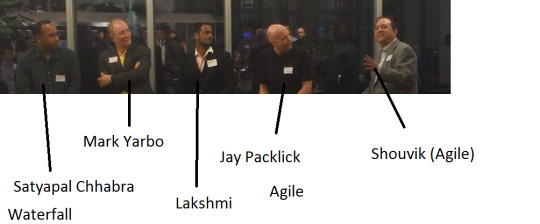#Mark Yarbro
Explore tagged Tumblr posts
Text
Subverting the federal government was on the minds of state lawmakers Thursday in an hours-long civics lesson from far-right speakers.
As promised in the 2023 session of the Tennessee General Assembly, the idea of nullification was heard during a summer study session in Nashville. The idea is, basically, for Tennessee to be able to nullify rules from the federal government that it does not like.
(Read our cover story — “Who’s Got the Power?” — from March to get more details on Tennessee, state sovereignty, and nullification.)
Bills to outline a nullification process in Tennessee go back to at least to 1995. A similar resolution passed in 2021 but it was specific to Covid. It condemned the federal government for mandating vaccinations, restrictions, or requirements.
Another came last year when state Rep. Bud Hulsey (R-Kingsport) and state Sen. Janice Bowling (R-Tullahoma) filed the ”Restoring State Sovereignty Through Nullification Act.”
In it, the legislature could decide what federal rules they wanted to follow or not. Also, if a voter scraped together 2,000 signatures, they could submit a petition for a nullification to the Speaker of the Tennessee House.
The bill gained very little traction, if any at all. Neither bill even got enough support to place it on the calendar for a full committee hearing. The idea was slated for a summer study review in 2023. However, that study was interrupted with a special session on school safety, in the wake of the Covenant School shooting that left six dead.
But Bulsey and Bowling’s idea did finally get that summer study review, even if it was actually in the fall of 2024. True to form on these sessions, Thursday’s hearing yielded no votes or promise of any course of action. It was purely for review.
The session was not a town hall. State Sen. Richard Briggs (R-Knoxville), the committee chairman, said he knew the idea was “controversial” but did not allow members of the public to speak, or clap, or boo. That right to speak came only for the experts called upon by the legislature. Those selected for this duty Thursday were roundly (and soundly) conservative.
Jeff Cobble is an attorney and member of the conservative Federalist Society. Joe Wolverton is the inaugural constitutional law scholar for the ultra-conservative John Birch Society. Mark Pulliam is an attorney and writer who, in an August blog post, prayed “… a single juror would vote for President Trump’s acquittal in the circus-like show trial …” in Manhattan.
The hours of their testimony ranged back to the Declaration of Independence, through the 1781 Articles of Confederation, and to 1787 when the U.S. Constitution was proposed. Lots of it dove deep into definitions of the words of the constitution, like “all,” for example.
“I’m going to take you like elementary school students through this so this is plain,” said Wolverton in a detailed section of the Constitution to elected lawmakers. “We��re going to go through it phrase by phrase.”
As for the meat of the separation of powers (and therefore what power Tennessee really does have in nullification), Wolverton presented his ideas wrapped like a click-bait-y YouTube video. “In an hour,” he began, “I can show you how the 14th Amendment is taught wrong.”
“State — capitalized — has a specific meaning,” he said. “It’s got to do with the sovereign. Nations today are nation states. They are sovereign.
“I’m suggesting to you something radical, something I did not learn in [constitutional] law. The states are sovereign over the federal government. Now, take that and chew on it. That’s what this bill’s about.”
Some spice in the meeting came late as state Sen. Jeff Yarbro (D-Nashville) began asking questions of the panel. He asked if the work of the Federal Emergency Management Agency (FEMA) helping out now in East Tennessee was an example of what they were taking about.
Yes, Cobble said, “It’s usurpation, whether it’s used for good or bad,” adding that communities come together in times of tragedy, noting specifically that “the Amish, they build their own barns. They raise their owns houses.”
“You know, good things can happen without a government,” he said. “So, my answer is yes, FEMA is clearly unconstitutional.”
15 notes
·
View notes
Text
DEAD AND BURIED (1981) – Episode 276 – Decades of Horror 1980s
“Dan, I’m dead! Please bury me!” That’s not something you hear every day. Join your faithful Grue Crew – Crystal Cleveland, Bill Mulligan, Jeff Mohr, and guest Gregory Crosby – as they discuss Dead and Buried (1981), a Stan Winston showcase.
Decades of Horror 1980s Episode 276 – Dead and Buried (1981)
Join the Crew on the Gruesome Magazine YouTube channel! Subscribe today! Click the alert to get notified of new content! https://youtube.com/gruesomemagazine
Gruesome Magazine is partnering with the WICKED HORROR TV CHANNEL (https://wickedhorrortv.com/) which now includes video episodes of Decades of Horror 1980s and is available on Roku, AppleTV, Amazon FireTV, AndroidTV, and its online website across all OTT platforms, as well as mobile, tablet, and desktop.
Synopsis: When visitors to the small, friendly, coastal town of Potter’s Bluff are mysteriously killed, Sheriff Gillis investigates and finds that the recently killed are reanimating and coming back to life.
Directed by: Gary Sherman (as Gary A. Sherman)
Writing Credits: Ronald Shusett & Dan O’Bannon (screenplay); Jeff Millar & Alex Stern (story); Chelsea Quinn Yarbro (novel)
Music by: Joe Renzetti
Cinematography by: Steven Poster
Makeup Department: Stan Winston (makeup effects designer)
Special Effects by: James Kagel (sculptor); James Cummins (lab technician) (uncredited)
Visual Effects by: Bill Hansard (process coordinator)
Selected Cast:
James Farentino as Sheriff Dan Gillis
Melody Anderson as Janet Gillis
Jack Albertson as William G. Dobbs
Dennis Redfield as Ron
Nancy Locke as Linda (as Nancy Locke Hauser)
Lisa Blount as Girl on the Beach / Nurse Lisa
Robert Englund as Harry
Bill Quinn as Ernie
Michael Currie as Herman
Christopher Allport as George Le Moyne / Freddie
Joseph G. Medalis as Doctor (as Joe Medalis)
Macon McCalman as Ben
Lisa Marie as Hitchhiker
Estelle Omens as Betty
Barry Corbin as Phil
Linda Shusett as Waitress (as Linda Turley)
Ed Bakey as Fisherman
Glenn Morshower as Jimmy
Robert Boler as Mr. Haskell
Michael Pataki as Sam
Jill Fosse as Nurse
Mark Courtney as Jamie
Michael Courtney as Jamie
Renee McDonell as Girl #1
Dottie Catching as Lady Car Passenger
Colby Smith as Female Stranger
Judy Ashton as Joyce
Anthony Cecere as Townsperson (uncredited)
Bill Couch Jr. as Townsperson (uncredited)
Bill Couch as Townsperson (uncredited)
Angelo De Meo as Townsperson (uncredited)
Dead and Buried (1981) is a phenomenal film! There is plenty to discuss regarding the making of this movie as well as the methods used to achieve its look. The Grue-Crew, joined by Gregory Crosby, are in awe of Stan Winston’s effects work. “Awe,” they say! Jack Albertson, in his last role, delivers his portrayal of the big-band-loving, splendidly attired mortician with style and grace. James Farentino’s character, the town sheriff, is put through the wringer as he tries to figure out just WTF is going on in “his” town. As Joseph Heller wrote and Sheriff Gillis learns, “Just because you’re paranoid doesn’t mean they aren’t after you.” Then, there’s that ending! Don’t get the Grue-Crew wrong. Dead and Buried has its flaws, but the good parts are so good!
Doc Rotten, The Black Saint, Christopher G. Moor, and Thomas Mariani discussed Dead and Buried in a previous episode of Decades of Horror 1980s published July 2016. You can listen to the audio-only podcast here: Dead and Buried — Episode 86 — Decades of Horror 1980s (https://gruesomemagazine.com/2016/07/14/podcast-dead-buried-episode-86-decades-horror-1980s/)
At the time of this writing, Dead and Buried (1981) is available to stream from Tubi, Pluto TV, Prime, Peacock, and Night Flight, and PPV from Apple TV. It is also available on physical media in various combinations of 4K UHD, Blu-ray, and soundtrack CD from Blue Underground.
Every two weeks, Gruesome Magazine’s Decades of Horror 1980s podcast will cover another horror film from the 1980s. The next episode’s film, chosen by Chad, will be Blue Monkey (1987). There are no real blue monkeys, but there is a giant insect that eats people. And in a hospital, yet! Oh boy!!
Please let them know how they’re doing! They want to hear from you – the coolest, grooviest fans – so leave them a message or comment on the Gruesome Magazine Youtube channel, on the Gruesome Magazine website, or email the Decades of Horror 1980s podcast hosts at [email protected].
Check out this episode!
0 notes
Text
Inside The Vault: A Carolina Panthers Podcast - Ep 23 - Fri Jan 12th 2024
Mark Yarbro co-host of the Afternoon Rush on 730TheGame joins host Ryan Smith. Mark and Ryan go through the Panthers GM and HC candidates, talk 2024 draft, free agent targets and more! Twitter: @MarkYarbro

View On WordPress
0 notes
Quote
who do you support waterfall or agile -agile is considered the method which will rule the future devlopment models
Waterfall vs. agile methodology Debate Part
Waterfall vs. agile

Speakers info:
First Person Name Satyapal Chhabra – Founder and Managing Principal at Ideliver – Waterfall
Satyapal is a household name and thought leader in the world of application delivery and testing. He has been advising companies on how to optimize their application lifecycle management process for nearly 2 decades. Satyapal is currently the Founder and Managing Principal of Ideliver, an award-winning Software Performance and Quality Assurance delivery company.
Second Person Name Mark Yarbro – Performance Test Manager at Bank of America – Waterfall
With over twenty years of hands-on, roll-up-your-sleeves experience in a wide variety of environments, both as a leader and as an individual contributor, Mark Yarbro is a Dallas application testing guru. At Bank of America, Mark is known for implementing best in class practices among his 32 performance testing engineers as they support multiple lines of business.
Third Person Name Jay Packlick – Principal, Enterprise Agile Coach at Sabre Corporation – Agile
Jay Packlick is an Enterprise Agile coach working with Sabre. He spent over twenty years of his career getting software done in a variety of roles. He’s dedicated the last fourteen years to learning and helping others implement better ways of achieving the outcomes that matter to them.
Fourth person name Shouvik Bhattacharyya – Serial Entrepreneur and Partner at B12 Consulting – Agile
Shouvik has been investing in Agile-centric practices and companies for the last eight years. These teams have been successful in enabling agile transformation in several large global enterprises, in Banking and Financial Services, Retail, Telecom, Airlines, etc. Shouvik has been CEO of public and private companies in the US, Europe, and Asia.

Names (left to right)
Left side-waterfall folks:
First Person –Satyapal Chhabra
Second Person– Mark Yarbro
Middle guy(lakshmi)- moderator
Right side-agile folks:
Third Person –Jay Pack lick
Fourth person– Shouvik Bhattacharyya
First link :
youtube
First Person (Satyapal Chhabra) – it does not necessarily address what agile world is but it has ratchets to go faster and quicker, take example talk about performance, if you look at the classical performance testing it gives you up to transition phase , it’s still a waterfall and we are going very much penetrations in a day to get the optimum state, so if you look at it , inclusion of all the aspects of people who are participating because the hype cases moves right there and you get value out of it, so chabra I am not gonna address , it’s just that the reality is how determines it , its traditional but it delivers and my argument, I am not a kings expert, I would say it’s a republican on democrats.

Second link:
youtube
First Person (Satyapal Chhabra)- That has worked which is a worenforen, we go back to basic, so agile is an adoption through new techniques of econorkia, the gap we are talking about is more of adoption from previous players, so there is something called product coring, product coring means eparchy, so eparchy doesn’t work, because I could be doing right thing in wrong direction all the life
Third person (Jay Packlick) -I am sorry
First Person (Satyapal Chhabra)-or you know it’s a classical discrepancy right, you did it right but wrong completely in wrong direction, you jock the wrong forest something like that
Middle guy moderator-great points on both the sides we realized for quite some time , moving on to the third way, this time I am going to flip the switch to the agile folks , what’s more important in your philosophy, is it the scope or the value
Third guy (Jay Packlick)- so scope or value, so first of all if you are describing them separately you have describing problem
Middle guy moderator– it’s described separately for the sake of the argument.
Third guy (Jay Packlick)-yeah it’s a false tied economy right? I mean ultimately I,

Third link:
youtube
Fourth person – Shouvik Bhattacharyya- i like to point it out in the agile world as long as you’re including the right set of
People you might decrease the scope dramatically because you will provide the right value so i think that’s why is becoming more and more
Popular because everybody speak to market today right so you cannot just think i am going to keep on increasing the scope and the customers gonna wait for me
Third person – Jay Packlick-i wanna give one real world example
Middle guy moderator –Real quick!!
Third person – Jay Packlick –Real quick!!,I was working with clients they had six months project, we had an algorithm to implement ,the potential for the algorithm was to increase revenue something like 5 million dollars per month , that was the value proposition and they were able to achieve that after 3 weeks, so now it works , they implemented the algorithm demonstrated that we can do that and it went into production in the end of four weeks so they dropped rest of the projects because there was other projects which had much higher return so I am just showing you an example decisions maximize value.if you are in business to make money tend to pay off you know!! If you update your plan
Middle guy moderator-true argument!!True argument from human value perspective. Scope or value what is the most important thing from the marching edge.
First person-Satyapal Chhabra- lets face it packlick, waterfalls perspective is the scope, not because they don’t want to deliver the value, the word inclusion right , the word inclusion has already covered every part of the scope, scope is given by someone who is qualified- (A)
B-they know the business or they are the business
Third person – Jay Packlick –They think they know, they are making a decision
First person-Satyapal Chhabra-I get it, one thing is , the waterfall again, in mean let’s face it it is something that is meant to deliver within the finite scope or finite cost and manufacture, agile means to, we can do it but we need inclusion by the right people or participation from right people that’s a Hugh assumption
Third person – Jay Pack lick –that’s true
First person-Satyapal Chhabra- that’s why agile becomes cyclic and goes for ever, it gets shelved or I don’t know, waterfall at least tends to deliver something which will be completely like a Motorola’s dynatac like a brick you can hit your wall ,I don’t you guys know about Motorola’s iridium product it was delivered like a brick you can hit your wall you can do dumbbells like that ,you can build muscles with it but you cannot make a phone call with that.
Third person Jay Packlick- the first question on the (can’t understand)
First person-Satyapal Chhabra- yes exactly, the point is that
Third person – Jay Packlick –so if you’re starting, you probably don’t want that much
First person-Satyapal Chhabra- so point is you went all the with 3 billion dollars investment, when you deliver something waterfall, yes agile would have given you the feedback early, I get the part but again it’s a where do you apply this, it’s up to the business or the IT team I would say to figure it out, what’s the best solution, right, so so, scope maybe encompassing the value
Third person Jay Packlick- so the scope raises the value is the subjective view from you. Mark do you like to add something?
Second Person Name Mark Yarbro-no I think shouvik is excited let him
Fourth person Shouvik Bhattacharyya-rise rise raise your hand if you want more stocks or more return on your investments. So raise your hands for stocks
Middle guy moderator- stock buyers come on rise your arms
Third person Jay Packlick-who want return on investment (ROI)? Yeah you are on the agile side, awesome.

Fourth link:
youtube
Second person – Mark Yarbro –develop is our singer what is , they are starting to work for the next spring, they are pulling things off the back ,when we all be planning on what are they gonna be working on the next spring, you know what that is , that’s waterfall. You’re doing four week water fall,
Third person- Jay Packlick –now he is talking
Second person – Mark Yarbro –in in historical methodology terms that’s more rare, rapid application development ,it’s a 1990’s term, that’s what most people do when theyu are calling it scrum or agile, I was trained in 2004 by people who were trained by( dash and dash-)we were trained in things they aren’t trained in anymore, its ugly, its messy, real scrum it’s so fun, its battle royal , its muddy , its sweaty and messy and you can get so much accomplished but it’s not pretty and management especially in big corporations are very on adamant, messy, seemingly off control kind of a process .The whole organization has to change and that’s when I learned the dirty secrets of scrum, agile you have to think differently act differently all up the chain and it’s hard to change people behavior
Middle guy moderator- sure
Second person – Mark Yarbro –it’s a superior methodology in a lot of ways but you don’t take it into account it’s like communism, socialism
Middle guy moderator along with the crowd– wooooooooooooooooooooooooo

Second person – Mark Yarbro –they don’t take into account the human factor no seriously you visually run out of other people’s money.
Middle guy along with the crowd- shouting and mumbling.
Fourth person Shouvik Bhattacharyya- last example, everybody is not obama here, we got two jams republicans vs. democrats so it’s our dish 480 million dollars were spent by a company in Canada, you guys know about this 480 million, what was the name of the company I forgot. yeah ok, 480 million and everything was held up right, it went blank , you couldn’t even login it was a mess, then they handed over to Accenture 90 million dollars and the guys delivered , I mean whichever side of the aisle you are , you can argue but from an IT perspective and whether you can login and deliver I do I act to it, so it’s a classic case to your point since you called us dominance, we are practical and realistic alright because we could gather to get in with, at the end of the day if you see I’ll go back to the other question scope vs. value the Canadian company were doing all the right things waterfall scope, there is Hugh scope

Middle guy making fun-a phrase
Third person Jay Packlick- so I am gonna throw myself before methodology don’t produce results; people right, so if you bring up an example we are guard less of our framework and someone is making a bad decision and I am not getting feedback on my that bad decision I am gonna!!, I am gonna!! Have a bad result
Second person – Mark Yarbro –right
Third person Jay Packlick- so its irregardless of your approach, I think where agile benefits Is if I do have a faster feedback, if I am legitimately using the information, I get it to say this words or doesn’t work then I have an opportunity at least to make a decision that leads to better results, I may ignore that data and I am gonna be 100 percent behind you
Fourth person Shouvik Bhattacharyya- he needs to change
Third person Jay Packlick- yeah , I am on the wrong side now I behave in north behavior real hard , real example, if I am gonna work right here boss , bad news I get fired, if I am working in a room where everybody shuts up when the boss walks in, if I am gonna play where people don’t give a crap, you know they just wanna get in get the paycheck and get out they don’t want to have a conversation, they don’t wanna do kumbayas and stand up, guess what they are probably not gonna succeed without framework and by all means fit your framework to meet your problems your cultural problem your problem space the worst thing you can do is to take Cinderella’s slippers and try to fit it on her big fat sister, because it ain’t gonna fit.

Fifth link:
youtube
Forth person Shouvik Bhattacharyya- The agile people when they think about planning they think about strategy in the plan, with waterfall people they think more about the plan itself , so that’s my thing you know, that’s the difference
Middle guy moderator-very well said , so strategy and blah blah blah, so having said that we have two sides of the view we’ll move on to the next war, talk about you know there are a lot of blah blah blah , talk about the activities , meanings ,inclusiveness has gravity through blah blah blah.
Second person Mark Yarbro- so inclusiveness we have 1200 applications today, and these things not all of them released, but we release 90 days later, the way that works is , we get everybody together so everyone is working locked still because it’s very difficult to release one product when it doesn’t line up with the others, we are doing like my world accordance testing , we are pushing loads through 30 different applications, they need to be ready all around the same time not just the apps , the platforms that’s been installed the ecosystems have to be released together, so we are living being we are living in space and time we move in single line that’s where waterfall hangs around because it has been working for 70 years, agile is a great way to get things done if you know what you need ,if the customer is not being clear but much more difficult to hold everyone to release the app in same time, so my argument is that you need highbred ,agile , here is the first job here agile
Middle guy moderator-keep it to your side

Second person Mark Yarbro- I will, oh (sarcasm), so you need to make doing the right things not just doing the wrong things badly
Third Person Name Jay Packlick-sure, sure.
Middle guy moderator-so your retenders and minor attributes are surely appreciated.
Second person Mark Yarbro- You’re welcome
Middle guy moderator-Thanks for that
First Person Name Satyapal Chhabra- that’s fine, just adding to it because that doesn’t prove them, methodology or the process eventually in waterfall, waterfall may be traditional tube and it has certain link available it has some fertile waterfall in which doesn’t necessarily add for agile world sense, so to look at performance, if you look at that classical performance carefully it gives you proper migration space, but instead of waterfall we are doing many penetrations in a day to get the optimum state

Please continue reading the sixth link
#waterfall agile waterfall vs agile casecamp best method of developmentsatyapal chhabra#Jay Pack lick#Shouvik Bhattacharyya#Mark Yarbro#obama corporate corporate discussion corporate insight rare debate rare corporate insight
1 note
·
View note
Text
See All of Hyram Yarbro’s Favorite Skincare Products

Look like the Gen Z skin-fluencer and TikTok star with these skincare products
Hyram Yarbro is the Gen Z skin influencer, or skin-fluencer, that everybody needs in their life. He’s the first one to tell you that the moisturizer you just bought is definitely not as clean as you think it is, and you’ll never see him promoting a brand on Instagram or TikTok just for the money. In fact, he’ll even put the most beloved brands on blast in the name of clear, glowing skin. The 24-year old has reached 3.8 million subscribers on YouTube since starting his skincare channel in 2018, and another 6.5 million on TikTok where he gives honest reviews on beauty products, gets gritty (pun intended) about skin care ingredients, and occasionally features celeb cameos from fans like Karli Kloss.
In fact, he’s even gained celebrity and influencer fans who specifically request him to review their skin care routines, just like he does for viewers on TikTok! This purple-haired skin care expert has made a mark on the beauty industry, switching up people’s skin care routines in a beautiful way to help them achieve their most healthy complexion. You can get the thumbs up from Hyram (he does this gesture a lot on TikTok) with these beauty products that he’s personally approved!
Check out Hyram Yarbro Favorite Skincare Products today!
#hyram yarbro#skincare#skincare products#beauty lovers#makeup#beauty#makeup addicts#skin care#TiKToK#influencer#skinfluencer
4 notes
·
View notes
Text
Doctors suggest you don’t take your beauty tips from TikTok

Doctors suggest you dont take your beauty tips from TikTok “I always know when something is trending on TikTok because I’ll have an influx of patients coming in and asking me about the same thing,” says Dr Niket Sonpal, a gastroenterologist. Most of the time, that “thing” is a beauty or wellness tip that’s gone viral on the video-sharing platform, without evidence that it actually works. The advice may be ineffective or outright dangerous, from drinking chlorophyll to induce weight loss, to using sunscreen only in select areas to “naturally” contour your face. “We talk about TikTok all the time in my office,” says Dr Dendy Engelman, a dermatologist and cosmetic surgeon, “and I think it might be worse than other platforms because people are really looking to create content with that wow factor, the thing that will go viral, even if it’s not grounded in science.” It’s not surprising that the app that brought us the “Benadryl challenge” (taking large doses of the antihistamine to induce hallucinations) and “the Everclear test” (doing shots of the high-proof alcohol) is not a fount of doctor-approved beauty guidance. But many consumers throw reason and caution to the wind when faced with these trends, underscoring a growing subversion of authority in which an influencer’s word is replacing that of experts. “It’s funny because patients are often so timid in our office about trying treatments,” Engelman says. “But when they see something done on Instagram from an 18-year-old influencer, they’re like, ‘Sure!’” What not to try at home Compiling an exhaustive list of TikTok’s bad beauty advice is next to impossible because the content on the platform seems to multiply in step with our increasingly short attention spans and insatiable craving for the new. But a few trends that have dominated the platform of late are especially mind-boggling to doctors. If people are seeing ‘results’ from drinking chlorophyll, it’s likely because they’re drinking more water than normal, so their skin is getting better and their bathroom trips are more regular Dr Niket Sonpal Take “slugging,” a TikTok trend advising people to sleep with a thick layer of Vaseline on their face to aid hydration. Videos with the hashtag have 14.4 million views on the platform, and the trend has been promoted by influencers like Hyram Yarbro and Cait Kiernan. But dermatologists warn that it can have adverse effects on your skin. “Putting an occlusive on your skin and letting it sit overnight sets you up for exacerbating clogged pores and breakouts,” Engelman says. Then there’s the “sunscreen contouring”, which dermatologist Dr Neera Nathan heard about, to her horror, from one of her patients. Some influencers have advised people tired of contouring their faces with makeup to use a thick sunscreen with high SPF, applying it only on the areas they want to highlight, like the top of the cheekbones and bridge of the nose. The rest of the face is left to tan (and burn), sunscreen free. It’s a tip that flies in the face of the American Academy of Dermatology’s recommendation that everyone wear a broad-spectrum SPF of at least 30 on any exposed skin. “We know that this is crucial to do from a very young age from both a skin cancer and anti-aging perspective, so the idea that these videos are suggesting otherwise to a very young audience is disturbing,” Nathan says. In April, drinking chlorophyll, which has had moments on other social media platforms, had a spike in interest on TikTok, driven by the endorsements of influencers like Amelie Zilber, according to Traackr, an influencer marketing platform. It has been called a “miracle product” that can increase energy levels, induce weight loss and clear up skin, but doctors say these claims are not backed by research. Drinking chlorophyll is one of the more harmless recommendations on TikTok, but it’s likely to be a waste of money. (Raw chlorophyll drops on Amazon cost about £15, on average.) “If people are seeing ‘results’ from drinking chlorophyll, it’s likely because they’re drinking more water than normal, so their skin is getting better and their bathroom trips are more regular,” Sonpal, the gastroenterologist, says. What trend do doctors really want to see left to the professionals? Microneedling, which involves puncturing the skin with tiny needles in an effort to generate new collagen. On TikTok, conversation around at-home microneedling grew in 2020 and is already experiencing five times more engagement in 2021, per Traackr, but experts say it’s incredibly risky to do at home. While some studies have shown that medical-grade microneedling can improve skin suppleness and lessen wrinkles, “it needs to be done in a really clean, safe setting,” Engelman says, pointing to the high risk of infection. “If you go hard enough on your skin, it can lead to colour change, textural change and scarring, essentially worsening what you’re trying to make look better, like fine lines and acne scars.” Viewer, beware Tilly Whitfeld, a reality TV star from Australia’s Big Brother, has learned firsthand just how dangerous beauty trends can be. After spending her time on the 24-hour surveillance-style show wearing clay face masks or heavy makeup, she was questioned by viewers about what she was hiding and confessed vaguely on Instagram in May that a TikTok beauty trend had damaged her skin. Whitfeld, 21, says by phone from Sydney that she hadn’t told anyone exactly what it was because she “knew” she would look like an idiot. Last August, she was browsing TikTok when she came across a video teaching people how to give themselves freckles using sewing needles and ink that were said to fade within six months. Since the video didn’t clarify what type of ink to get, she ordered brown tattoo ink she found on eBay, which she later discovered was a counterfeit product made with high levels of lead, and began pricking her face in a freckle pattern. “It didn’t hurt at all, so I didn’t think I should stop,” says Whitfeld, who went over the marks multiple times, as advised by the video’s creator. There weren’t any faux freckles, and her face swelled up from infection, which caused her to briefly lose sight in one eye, she says, and she now has scarring across her cheeks and nose. With nearly $12,000 already sunk into doctor’s visits, Whitfeld has yet to find a solution to correct the damage. Laser removal is apparently not an option because, doctors have told her, the ink she used will turn black rather than fade. “The main response has been that I’m stupid, and, yeah, I agree,” she says. For doctors, it’s a terrifying scenario. “You have a lot of people claiming to be experts who have no real consequences for giving really bad advice,” Sonpal says. Stories like Whitfeld’s have doctors hoping that the companies running these platforms will place disclaimers on beauty content stating that it’s unverified or dangerous to try at home, but they’re not holding their breath. In the meantime, they’d prefer that you reach out to, yes, a doctor, via appointment or direct message on social media, before putting your faith in a TikTok video. As Sonpal puts it, “We can counsel and educate you for more than 60 seconds.” Doctors suggest you don’t take your beauty tips from TikTok Read the full article
0 notes
Photo

False Dawn by Chelsea Quinn Yarbro $4 Warner Books First Printing (1989) We follow Thea and Ethan's harsh crossing of barren, polluted landscapes torn by human and animal violence. In this novel, Chelsea Quinn Yarbro shows the importance of mutual assistance to survive. The cover art is by Jim Dietz. . Overall Good Condition, Pages Look Great, Shelf Wear, Bottom-Right Of Cover Folded, Publisher's Remainder Mark On Top Edges Of Pages (Stamped '4') . . . #falsedawn #chelseaquinnyarbo #paperbacksciencefiction https://www.instagram.com/p/B7t3HAxgMTm/?igshid=l3m4p5n73fog
0 notes
Text
What I Learned In My First Term in Div School: Life in the Musterion

“Whatever is unsure is possible, and life is bigger than flesh. Beyond reach of thought, let imagination figure.” – Wendell Berry
For the last couple months, I’ve been absolutely taken with the Greek word μυστήριον. The word has been a great help to me during my first term at YDS, and after facing months of epistemological anxiety, I’ve come to fall in love with the musterion itself. This blog post is wee attempt to share the word’s scriptural background and point to its tremendous bearing on our theological questions today. Here we go!
So, what is the ‘musterion?’
Between the gospels, the epistles, and the book of Revelation, canonical New Testament writers mention ‘mystery’ 27 times. Included among these is Mark, who writes about the musterion in his Parable of the Sower account. In this passage, after giving a cryptic teaching about sowing, weeds, and thorns to a large group, Jesus meets inside a home with His followers, who ask about the parables’ meaning. Rather than answering the question outright, Jesus responds: “To you has been given the secret of the kingdom of God, but for those outside, everything come in parables.” Though many translations write “secret,” Mark uses the Greek word musterion, which implies both secret and mystery. In the following verses’ fuller answer, it is as if Jesus says, ‘Seeds grow fully on good soil. The word spoken to you contains greater mysteries than you could ever imagine about the Kingdom of God. You can’t see everything with your eyes now, because it’s a secret seed buried deep within you—but you can see the love and justice that sprouts up from a life filled with the word and mystery of my Kingdom. You won’t understand it all, but it will grow in you and around you, like seed on good soil, for all who receive my teaching.’ For Jesus’ followers, the mystery of God’s Kingdom is a gift that grows within them and in the world around them.
Jesus’ disciples sensed elements of God’s Kingdom rising around them—like seeds slowly beginning to grow. Jesus healed those with long-term illnesses, liberated those tormented by demons, and honored one of the community’s poorest members. Jesus came to liberate the oppressed, free the captives, and show those around Him how to love. Perhaps the disciples could feel their own hearts changing; slowly but surely becoming more forgiving, less resentful, more grateful, and more aware of the world’s systematic injustices. In these ways, the Kingdom of God seemed present, but it is still mysterious. It was (and is) still growing. There is so much more to come. For now, the world’s spiritual changes remain a mystery. Who can say how seeds grow? It is not until the ‘next chapter’—when heaven comes to earth—that we will find out what the mystery is. On that day, we will see the seeds’ full growth.
Luke writes that a child is born to us, “to you is born this day in the city of David a Savior, who is the Messiah, the Lord,” and Mark writes that a mystery is given to us. The gifts are more intimately related than we have ever known.
If we hold Jesus, we hold these mysteries, too.
What does this mean for us today?
For many of us, the story of Jesus is so familiar that we never think about the bright, wondrous mysteries woven within it. As such, we scramble to clarify every theological grey-area (and there are many.) I propose that Christ calls us to allow our thoughts, instead, to be animated by the awe-struck joy and humility which comes from not fully knowing, yet holding, the mystery of the Kingdom of God. The sacraments are an example. We hold the communion bread without ever knowing its total significance. Simone Weil writes of the Eucharist, “He must be more completely present in a morsel of consecrated bread. His presence is more complete in asmuch as it is more secret.” Who can fully comprehend the wondrous, mysterious secret of communion? How can you or I understand the mystery of God’s great Kingdom planted deep within us?
We don’t need to have all the answers. In fact, a cosmological cipher is “a vain fiction and chimera.” (A. Conway) Jesus invites us to move beyond understanding; to open our eyes to the divine secrets unfolding around us, and to live a life of love within God’s great mystery. Spring is near, and the Kingdom of God is the seed planted within you.
_________________________________________________________________
Bibliography 1. Boring, Eugene M. Mark: A Commentary. Louisville, KY: Westminster John Knox Press, 2006.; 2. Bowker, John W. "Mystery and Parable: Mark Iv. 1—20." The Journal of Theological Studies, New Series, 25, no. 2 (1974): 300-17. http://www.jstor.org/stable/23958404.; 3. Brown, R.E. The Semitic background of the term "mystery" in the New Testament. Philadelphia, PA: Fortress Press, 1968.; 4. Collins, Adela Yarbro. Mark. Edited by Harold W. Attridge. Hermeneia Commentaries. Minneapolis, MN: Fortress, 2007.; 5. Collins, Adela Yarbro. "Messianic Secret and the Gospel of Mark: Secrecy in Jewish Apocalypticism, the Hellenistic Mystery Religions, and Magic." In Rending the Veil: Concealment and Secrecy in the History of Religions, by Elliot R. Wolfson, 11-30. New York, NY: Seven Bridges Press, 1999.; 6. Evans, Craig A. "A note on the function of Isaiah, VI, 9-10 in Mark, IV." Revue Biblique (1946-) 88, no. 2 (1981): 234-35. http://www.jstor.org/stable/44088534.; 7. Lane, William L. The Gospel according to Mark; the English text with introduction, exposition, and notes. New International Commentaries on the New Testament. Grand Rapids, MI: Eerdmans, 1974.; 8. Marcus, Joel. "Mark 4:10-12 and Marcan Epistemology." Journal of Biblical Literature,103, no. 4 (1984): 557-74. doi:10.2307/3260467.; 9. Marcus, Joel. Mark 1-8. Vol. 1 of Mark. AB 27. Anchor Bible Series. New York, NY: Doubleday, 1964.; 10. Marcus, Joel. The Mystery of the Kingdom of God. Atlanta, GA: Scholars Press, 1986.; 11. Moule, C.F.D. “Mystery.” Pages 479–481 in vol. 3 of The Interpreter’s Dictionary of the Bible: An Illustrated Encyclopedia. Edited by George A. Buttrick. 4 vols. New York, NY: Abingdon Press, 1962.; 12. Mowry, L. “Parable.” Pages 649–654 in vol. 3 of The Interpreter’s Dictionary of the Bible: An Illustrated Encyclopedia. Edited by George A. Buttrick. 4 vols. New York, NY: Abingdon Press, 1962.; 13. Williams, James G. Gospel against Parable: Mark’s Language of Mystery. Decatur, GA: Almond, 1985.; 14. Schiffman, Lawrence H. "Mysteries." In Qumran Cave 4, vol. 15: Sapiential Texts, Part 1 (DJD 20), by Torleif Elgvin, et. al. Oxford, UK: Clarendon Press, 1997.; 15. Schiffman, Lawrence H. Reclaiming the Dead Sea scrolls: the history of Judaism, the background of Christianity, the lost library of Qumran. Philadelphia, PA: Jewish Publication Society, 1994; 16. Eusebius. Eusebius: The Church History. Translated by Paul L. Maier. Grand Rapids, MI: Kregel Publications, 1999.; 17. Irenaeus, and Aeterna Press. Irenaeus Against Heresies. London, UK: Aeterna Press, 2016.
0 notes
Text
All of the usual sights and sounds of the season signal the Thanksgiving weekend. Autumn’s palette cast a warm glow across campus. As we at MTSU winded down for the holiday, students were excitedly preparing for a long weekend home, as faculty and staff discussed time-honored recipes that were going to grace the family table.
This year, however, the family hugs and homebound journeys that represent the essence of the holiday stirred mixed feelings for our campus community.
Don’t get me wrong. We are thankful, deeply thankful. Indeed, the measure of our gratitude has grown and deepened in direct proportion to the hardships experienced and witnessed as a result of Hurricane Dorian’s early September landfall on The Bahamas. The devastating impact of 185 mph winds shifted our understanding of how the concept of home can change in an instant.
In its aftermath, some 70,000 people were left homeless from the destructive storm that devastated the island nation. With MTSU’s 51 currently enrolled students from the Bahamas, seven of whom with families living in the most affected areas of Grand Bahama and Abaco islands, this natural disaster hit particularly close to the hearts of our university family. For me, Hurricane Dorian also hit close to home. As a proud Bahamian-American, it is the place of my birth, and it remains the home for many in my large, extended family.
Our students, faculty, staff, alumni and supporters responded to this humanitarian crisis with an outpouring of assistance through the Raider Relief giving campaign, resulting in the delivery of tens of thousands of pounds of disaster relief supplies. MTSU’s Trustees Vice Chair Darrell Freeman and R.J. Young Co. CEO Chip Crunk also generously donated the use of their private planes, as well as their valuable time, to pilot the aircraft and personally deliver supplies to affected families.
The caring and kindness that has fueled Raider Relief has been nothing short of inspiring. Stories of our students’ families who have lost belongings, homes, and jobs have opened our eyes to how fate and circumstances beyond one’s control can upend all sense of normalcy in the blink of an eye.
Closer to home, the hardships associated with homelessness are no less important, but the weight of this burden on students is not always clearly visible. Shame and embarrassment cloak the issue, making it less transparent and certainly not easy for students to voice.
Typically, homelessness manifests itself as a result of numerous sets of circumstances. A parent or student being laid off from a job, a serious illness, injury, or any number of life’s unpredictable challenges can contribute to a student facing circumstances in which they find themselves without a roof over their head or a place to call their own.
Indeed, the reasons why students experience homelessness or housing insecurity are as varied as the lives of students themselves, and oftentimes are of no fault of their own.
Likewise, our understanding of the factors contributing to homelessness can be unclear and our perceptions ambiguous.
At MTSU, we strive to make the subject approachable and resources readily available.
Two such efforts were recently on clear display. A fall dance concert featured a performance by Chicago-based guest choreographer William Gill titled “This Too Shall Pass,” which opened by exposing the harsh realities of living on the streets, and concluded by celebrating the panacea of community, family, and support. Promotions leading up to the concert encouraged attendees to bring donations of blankets, sleeping bags, and tents for the nonprofit Murfreesboro Cold Patrol.
While tailgating festivities the next day bolstered the efforts of “Warm Bodies and Full Bellies: Helping the Homeless One Giving Act at a Time,” a project spearheaded by marketing students with the goal of collecting nonperishable food and warm clothing in partnership with Greenhouse Ministries.
Six years ago, Virginia Hemby, a professor of business education in our Jones College of Business, established Raiders’ Closet, a service to provide students in need professional clothing for job interviews and networking opportunities.
Through partnerships with businesses like AstraZenca and Dillard’s department stores, Raiders’ Closet collects and distributes new and gently used clothing and provides guidance and advice on professional wardrobe choices. In collaboration with MTSU’s Career Development Center, these services help students prepare for interviews and land a good paying job, gaining a sense of independence and security that comes with steady employment and income.
Jones College professor Philip Seagraves, who runs our real estate studies program, noted that dramatic events experienced during adolescence can have a strong effect on life choices and perceptions about matters regarding investment, career, and family decisions, which carry into adulthood. If a students’ formative years were marked by economic turmoil, foreclosure, and being evicted from their home, this could naturally lead them to second guess the American dream of homeownership. Professor Seagraves said he also knows from experience that these doubts can be overcome.
He proudly recalled the story of a former student who was homeless, but persevered to graduate, became gainfully employed at a local mortgage company, and is currently doing very well. “Getting some stability in his home situation made a difference — along with others taking an interest and giving a helping hand,” concluded Seagraves.
Student organizations have also taken an active role in providing support. MTSU’s Student Food Pantry is sustained by food drives that collect nonperishable items, which are available for students in need at no charge. Our fraternities and sororities engage in friendly competitions and student organizations host events with the goal of raising funds to purchase food or to accept food donations for the pantry.
Earlier this year, when state Rep. Carson W. Beck and state Sen. Jeff Yarbro sponsored a bill in the Tennessee General Assembly in an endeavor to aid this underserved student population, they turned to MTSU and asked us to present our program focused on helping homeless students as a model to other colleges and universities across the state.
Their bill was enacted into law and, as of July 1, each post-secondary educational institution funded by the state is required to designate a liaison to homeless students and develop a program to give them access to housing.
In recognition of MTSU’s decade-long reputation as a leader in addressing the issue of homelessness, Becca Seul, associate director of MTSU’s MT One Stop, and Danielle Rochelle, coordinator of outreach and support programs, were selected to testify in support of the bill. Seul and Rochelle’s contributions as consultants for the statewide mandate include the creation of a manual detailing how other schools can start a homeless student program and how to obtain community resources to fund operations.
Unless you’ve been through such a predicament or personally know someone who has, it’s hard to fathom the strength and resolve required to attend college while navigating the uncertainty of being without a home. The unknown can be frightening, not only to the person experiencing it directly, but also to those observing from the outside and trying to make sense of the situation.
While it may be tempting to speculate on the circumstances that led to the homelessness or even judge, I think we can all agree, if a student holds the insight that pursuing a college degree can lead to a brighter future, and they possess the determination to persevere, they deserve our support to help them achieve this goal.
When new students join the MTSU community, they join in a noble tradition of reciting our True Blue Pledge, which includes a commitment to being an engaged member of our community, and serving as a giver when the need arises.
In this season of Thanksgiving, let’s give thanks for the abundance of blessings that we enjoy, and pledge to seek solutions to help those experiencing homelessness to stay steadfast in their path toward a better a life and toward place that they can call their own.
#gallery-0-5 { margin: auto; } #gallery-0-5 .gallery-item { float: left; margin-top: 10px; text-align: center; width: 50%; } #gallery-0-5 img { border: 2px solid #cfcfcf; } #gallery-0-5 .gallery-caption { margin-left: 0; } /* see gallery_shortcode() in wp-includes/media.php */
Tiara Ashley Brown, president of MTSU’s Bahamian Student Organization, helps unload a plane full of supplies after it arrived Friday, Sept. 20, in her native Bahamas as part of the MTSU Raider Relief’s third trip to the island commonwealth to assist the families of students affected by the devastating Hurricane Dorian. Brown, whose organization also collected supplies in the relief effort, accompanied MTSU President Sidney A. McPhee and others on the latest relief mission. (MTSU photo by Andrew Oppmann)
Representatives of the MTSU Greek Week committee, MTSU Fraternity and Sorority Life, and the Student Food Pantry stand in front of the thousands of donated nonperishable food items collected during the spring 2019 Greek Week food drive to replenish the pantry. Pictured, from left, outside FSL’s Student Union offices, are FSL Director Leslie Merritt; Danielle Rochelle, MT One Stop outreach coordinator who oversees the Student Food Pantry; Jordan Borchert, FSL coordinator; junior Deshaun Covington of Phi Beta Sigma fraternity and Greek Week committee member; and senior Alex Revor, member of Chi Omega sorority and Greek Week committee chair. As noted by the sign, the food drive collected 7,764 items and $2,084.50 in funds. (MTSU file photo by Jimmy Hart)
MTSU gives thank to be able to help those in need All of the usual sights and sounds of the season signal the Thanksgiving weekend. Autumn’s palette cast a warm glow across campus.
0 notes
Text
President And Mrs. Polk To Stay Buried In Nashville
NASHVILLE, TN — The issue of relocating the bodies of President James K. Polk and his wife Sarah is – pardon the expression – dead and buried.
A subcommittee of the Tennessee State Senate’s State and Local Government Committee sent the resolution authorizing the removal of the President and First Lady from their resting place on the grounds of the state capitol to so-called "summer study," a legislative nicety that is almost always a euphemistic way of killing a measure.
Barring an unusual turn of events in the Senate, which regards the committee process as sacrosanct, the move essentially ends the effort to move the Polks from where they’ve lain since 1893 to the grounds of a house built by Polk’s father in Columbia, 50 miles south of Nashville.
Touted by the James K. Polk Memorial Association as a move to a more appropriate place of repose that would generate more interest, the effort has been lambasted and excoriated by historians, legislators and some descendants of the Polks since it emerged early last year.
Interestingly, the failure of the resolution comes on the heels of a U.S. House committee reporting favorably on a bill authorizing the Department of the Interior to study adding the Polk House to the National Park Service. That bill, sponsored by Rep. Scott DesJarlais, had languished in the mire of the House committee process for years.
Subscribe
A 1981 state law requires the approval of the General Assembly to relocate the couple. The Senate approved a resolution of support, sponsored by Republican Sen. Joey Hensley, late in last year’s session, but the House of Representatives never took up the bill, forcing the resolution back into the normal legislative pipeline after the General Assembly reconvened in January. Nashville State Sen. Jeff Yarbro, a Democrat, was among the most vocal opponents of the effort, though he was chastised by Republican colleagues for characterizing it as "macabre." Yarbro, along with Senate Majority Leader Mark Norris, said that the legislative effort was premature because the move also requires approval by the Tennessee Historical Commission and the Davidson County Chancery Court.
Under the Tennessee Heritage Preservation Act of 2016, passed as a result of an effort by the city of Memphis to relocate a statue of Confederate general Nathan Bedford Forrest, slave trader, Confederate general and an early Ku Klux Klan leader, the relocation of any memorial or monument dedicated to an historic figure is prohibited unless a waiver is granted by a 2/3 vote of the Tennessee Historic Commission. As Confederate statues have come down across the South, that law has been under the microscope once again, notably after Memphis sold city parks for a peppercorn fee to private non-profits, leading to the removal of the statue of Forrest and another of Jefferson Davis.
The executive director of the THC wrote to the James K. Polk Memorial Association saying that relocating the Polks’ bodies would be "inappropriate" and "ahistorical" and said the THC would never support the initiative. Tennessee’s state historian and numerous members of the Polk family have also expressed opposition.
The Polk Memorial Association operates the ancestral home in Columbia. The President and Mrs. Polk never lived there – Polk was in law school at the University of North Carolina when his father built the house and spent his adult life in Nashville and Washington; he died in Nashville shortly after leaving the Oval Office.
Polk’s will specifically said he wanted to be buried in Nashville.
"Sarah Polk, and myself, have mutually agreed with each other, that at our respective deaths, it is desired by us, that our bodies may be interred on the said premises, which I have denominated the Polk Place," the president wrote, referring to the now-demolished Polk Place, according to a copy of his will reprinted in a 1956 issue of the Tennessee Historical Quarterly.
Nevertheless, the president was briefly buried at the Nashville City Cemetery after his death before he was moved to Polk Place. After her death in 1891, Sarah Polk was buried next to her late husband and they remained there until 1893 when they moved to the capitol grounds.
Polk Place was nearly purchased by the state but was ultimately demolished after contentious family battle that involved the arcane rule against perpetuities.
Hensley and the Polk Memorial Association say the Polks are "ignored" at their current resting place and that it is not ADA accessible, though relatively flat and smooth sidewalks do wind their way to the tomb. The THC and historians are concerned that the effort to move the bodies to Columbia is an effort to boost tourism and interest in the president’s father’s home, while backers say they simply want to properly honor the Polks and their "wishes," despite what the President’s will makes clear.
Photo by Olivia Lind, used with permission
Source Article
The post President And Mrs. Polk To Stay Buried In Nashville appeared first on PAGESFESTIVAL.
Read More At: http://www.pagesfestival.com/president-and-mrs-polk-to-stay-buried-in-nashville/
0 notes
Text
Creepshow (1982) – Episode 149 – Decades of Horror 1980s
"Go out and fuck somebody. But wear a damn rubber! Everybody's got the damn herpes these days!" You can always count on Upson Pratt to let everyone know what’s bugging him. Join your faithful Grue Crew - Crystal Cleveland, Chad Hunt, Bill Mulligan, and Jeff Mohr - as they savor the sweet goodness that is George A. Romero’s Creepshow (1982).
Decades of Horror 1980s Episode 149 – Creepshow (1982)
An anthology that tells five terrifying tales based on the E.C. horror comic books of the 1950s.
IMDb
Director: George A. Romero
Writer: Stephen King (original screenplay by)
Special makeup effects: Tom Savini
Cast
Prologue and epilogue
Joe King as Billy
Iva Jean Saraceni as Billy's mother
Tom Atkins (uncredited) as Stan
Marty Schiff as Garbageman #1
Tom Savini as Garbageman #2
"Father's Day"
Jon Lormer as Nathan Grantham
Viveca Lindfors as Bedelia Grantham
Elizabeth Regan as Cass Blaine
Warner Shook as Richard Grantham
Ed Harris as Hank Blaine
Carrie Nye as Sylvia Grantham
Peter Messer as Yarbro
John Amplas as Nathan's Corpse
Nann Mogg as Mrs. Danvers
"The Lonesome Death of Jordy Verrill"
Stephen King as Jordy Verrill
Bingo O'Malley as Jordy's father and Doctor
"Something to Tide You Over"
Leslie Nielsen as Richard Vickers
Gaylen Ross as Becky Vickers
Ted Danson as Harry Wentworth
Richard Gere (uncredited) as Man On TV
"The Crate"
Hal Holbrook as Henry Northup
Adrienne Barbeau as Wilma "Billie" Northup
Fritz Weaver as Dexter Stanley
Don Keefer as Mike the Janitor
Robert Harper as Charlie Gereson
Darryl Ferrucci as Fluffy The Crate Beast
"They're Creeping Up on You"
E. G. Marshall as Upson Pratt
David Early as White
Ann Muffly (uncredited) as the voice of Lenora Castonmeyer
Mark Tierno as the voice of Carl Reynolds
Ned Beatty (uncredited) as the voice of Bob Bean
Longtime listeners may be sensing a bit of déjà vu with this episode. Creepshow was already discussed by Doc Rotten, Thomas Mariani, Christopher G. Mohr and Dave Dreher on episode 94 in October 2016. The current Decades of Horror 1980s Grue-Crew, however, didn’t want to be left out and because this fall saw the premiere of Creepshow the TV series on the Shudder streaming service, they thought it was the perfect time for another 1980s double tap.
When a movie is directed by George A. Romero with special makeup effects by Tom Savini; is written by Stephen King; features a comic book with cover art by Jack Kamen and interior art by Berni Wrightson; and a cast that includes Ed Harris, Leslie Nielsen, Ted Danson, Hal Holbrook, Adrienne Barbeau, Fritz Weaver, and E. G. Marshall; do you need to know anything else? Neither did the Decades of Horror 1980s Grue-Crew.
Gruesome Magazine’s Decades of Horror 1980s is part of the Decades of Horror 3-week rotation with The Classic Era and the 1970s. For their historic episode 150, the 80s Grue-Crew will Killer Klowns from Outer Space (1988).
Please let them know how they’re doing! They want to hear from you – the coolest, grooviest fans: leave them a message or leave a comment on the site or email the Decades of Horror 1980s podcast hosts at [email protected]
Check out this episode!
0 notes